Kathryn Troy's Blog, page 23
March 19, 2017
The Sacrifice - A Waste of a Bog Body
I've been watching films to help my mind unwind, and forget about bog bodies for a while. Imagine my surprise when I flip on Sacrifice (2016), starring my Silent Hill fave Radha Mitchell, and find her with a bog body!!
This dark thriller had a lot of great potential, but essentially suffered from too many ideas and a lack of direction. Here's the short list of all the things this movie was about-I think.
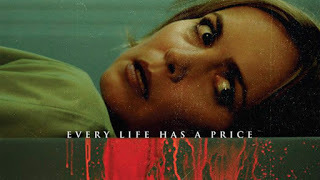 *Scottish lords with lots of second wives
*Scottish lords with lots of second wives
*An obstetrician with fertility problems
*The ritualistic killings of bog bodies
*Unrecorded missing women
*An island orphanage where all the babies coincidentally have the same eyes
*Scottish folklore & secret societies
*Island-wide conspiracies and coverups
*A Scottish heir trying to shuck off his legacy
When you put them together like this, the movie sounds interesting. While I was watching it, I kept waiting for these threads to be pulled together into some kind of deeper, cohesive unit. That moment never came. The movie is part murder mystery part thriller with gothic undertones, but it could never decide between those things, so the mood is muddled, and the narrative overall suffered. It also meant that they never went far enough with their story to be really compelling. Not enough twists for a good mystery, nowhere near dark enough to properly be called horror, and very confusing reveals and character development. The protagonist was too oblivious to be believable, but her silliness was required to get her into situations that moved the plot forward. Plus, I saw the villain(s) coming a mile away, don't know what the hell the husband thought he was doing, and worst of all: when everything was explained, I had to rewind and watch it again to understand. Twice! And it still didn't make any goddamned sense!

At any rate, I promise better bog people. Oh yeah, did that get lost in there? Whoops, sorry, don't know how they got into this movie in the first place...Really.
If I made it sound good and then let you down with my review, never fear. I always come with a backup-I heartily recommend Wake Wood (2009). SOOOO much better, and SOOO much darker. Oh, and it stars

K Rating: 7/10
This dark thriller had a lot of great potential, but essentially suffered from too many ideas and a lack of direction. Here's the short list of all the things this movie was about-I think.
 *Scottish lords with lots of second wives
*Scottish lords with lots of second wives*An obstetrician with fertility problems
*The ritualistic killings of bog bodies
*Unrecorded missing women
*An island orphanage where all the babies coincidentally have the same eyes
*Scottish folklore & secret societies
*Island-wide conspiracies and coverups
*A Scottish heir trying to shuck off his legacy
When you put them together like this, the movie sounds interesting. While I was watching it, I kept waiting for these threads to be pulled together into some kind of deeper, cohesive unit. That moment never came. The movie is part murder mystery part thriller with gothic undertones, but it could never decide between those things, so the mood is muddled, and the narrative overall suffered. It also meant that they never went far enough with their story to be really compelling. Not enough twists for a good mystery, nowhere near dark enough to properly be called horror, and very confusing reveals and character development. The protagonist was too oblivious to be believable, but her silliness was required to get her into situations that moved the plot forward. Plus, I saw the villain(s) coming a mile away, don't know what the hell the husband thought he was doing, and worst of all: when everything was explained, I had to rewind and watch it again to understand. Twice! And it still didn't make any goddamned sense!

At any rate, I promise better bog people. Oh yeah, did that get lost in there? Whoops, sorry, don't know how they got into this movie in the first place...Really.
If I made it sound good and then let you down with my review, never fear. I always come with a backup-I heartily recommend Wake Wood (2009). SOOOO much better, and SOOO much darker. Oh, and it stars

K Rating: 7/10
Published on March 19, 2017 17:53
March 12, 2017
Age of Myth - Fantasy Fun for Everyone
For anyone paying attention, it has been a while since I posted a book review. All of my most recent content has been either film reviews or articles about writing. There's a reason.
 I go through phases as an author-when I'm researching or outlining a WIP, I'm also reading in large spates, and don't watch a whole lot of films. But when I'm writing, I read very little, because I run out of head space, and I can't conjure up my own world on top of somebody else's. Movies, then, become my leisure time. That's the trend you're seeing. I'm eyeball-deep in Up from the Bog. I'm very pleased with its progress, and hope to share more about that project with you soon(ish).
I go through phases as an author-when I'm researching or outlining a WIP, I'm also reading in large spates, and don't watch a whole lot of films. But when I'm writing, I read very little, because I run out of head space, and I can't conjure up my own world on top of somebody else's. Movies, then, become my leisure time. That's the trend you're seeing. I'm eyeball-deep in Up from the Bog. I'm very pleased with its progress, and hope to share more about that project with you soon(ish).
In the meantime, I have been listening to audiobooks during my very long commute, and recently finished Age of Myth by Michael J. Sullivan. I've never read any of his books before, but did not need prior knowledge of his series Riyria Revelations to enjoy the beginning of this new saga, Legends of the First Empire .
The fantasy tropes are fairly standard: bad omens, world coming to an end, unlikely orphaned hero emerges. That being said, the many nuances of Sullivan's storytelling were unique and vibrant, and reminded me that it is possible to have been exposed to similar things and still be surprised and refreshed by them. Killing gods (or beings who only think they are) is certainly not something you see every day. And I am a sucker for myths, gods, and goddesses.
 I'd have a wolf named Mina for a companion too, if
I'd have a wolf named Mina for a companion too, if
I thought I could get away with it.The story was saturated with humor, something I appreciated very much here that is not normally to my taste. It was done quite well, and made the characters authentic and relateable as the world-building deepened. It helped immensely in this instance to have the humor narrated, and narrated excellently, so I could laugh out loud in my car from one comedic/fantasy situation to the next. The women in Dahl Ren were fabulous. Another thing I picked up on was the heavy influence of British lore, made more sharp by the British narrator and his many accents from all over the U.K. I only noticed such things-traditions about certain kinds of spirits, like trees-because of my own research for the bog story. Not too much on the nose, but suited very well to its traditional fantasy trappings.
The most unique aspects of the story, for me, were certain elements of the world-building, especially in naming conventions. Those pleased me the most, as did the carefully wrought scenes of the young mystic Suri, reading bones through fire, for instance. Grounded in this world's supernatural traditions, yes, but still compelling.
I would recommend this series to fantasy fans of all sorts, for there's really nothing not to like here. If anything, perhaps he's playing it too safe. Not in those last few lines, though, the sly dog. Only time will tell.
K Rating: 8/10
**New author goal** 6 out of 30
 I go through phases as an author-when I'm researching or outlining a WIP, I'm also reading in large spates, and don't watch a whole lot of films. But when I'm writing, I read very little, because I run out of head space, and I can't conjure up my own world on top of somebody else's. Movies, then, become my leisure time. That's the trend you're seeing. I'm eyeball-deep in Up from the Bog. I'm very pleased with its progress, and hope to share more about that project with you soon(ish).
I go through phases as an author-when I'm researching or outlining a WIP, I'm also reading in large spates, and don't watch a whole lot of films. But when I'm writing, I read very little, because I run out of head space, and I can't conjure up my own world on top of somebody else's. Movies, then, become my leisure time. That's the trend you're seeing. I'm eyeball-deep in Up from the Bog. I'm very pleased with its progress, and hope to share more about that project with you soon(ish).In the meantime, I have been listening to audiobooks during my very long commute, and recently finished Age of Myth by Michael J. Sullivan. I've never read any of his books before, but did not need prior knowledge of his series Riyria Revelations to enjoy the beginning of this new saga, Legends of the First Empire .
The fantasy tropes are fairly standard: bad omens, world coming to an end, unlikely orphaned hero emerges. That being said, the many nuances of Sullivan's storytelling were unique and vibrant, and reminded me that it is possible to have been exposed to similar things and still be surprised and refreshed by them. Killing gods (or beings who only think they are) is certainly not something you see every day. And I am a sucker for myths, gods, and goddesses.
 I'd have a wolf named Mina for a companion too, if
I'd have a wolf named Mina for a companion too, ifI thought I could get away with it.The story was saturated with humor, something I appreciated very much here that is not normally to my taste. It was done quite well, and made the characters authentic and relateable as the world-building deepened. It helped immensely in this instance to have the humor narrated, and narrated excellently, so I could laugh out loud in my car from one comedic/fantasy situation to the next. The women in Dahl Ren were fabulous. Another thing I picked up on was the heavy influence of British lore, made more sharp by the British narrator and his many accents from all over the U.K. I only noticed such things-traditions about certain kinds of spirits, like trees-because of my own research for the bog story. Not too much on the nose, but suited very well to its traditional fantasy trappings.
The most unique aspects of the story, for me, were certain elements of the world-building, especially in naming conventions. Those pleased me the most, as did the carefully wrought scenes of the young mystic Suri, reading bones through fire, for instance. Grounded in this world's supernatural traditions, yes, but still compelling.
I would recommend this series to fantasy fans of all sorts, for there's really nothing not to like here. If anything, perhaps he's playing it too safe. Not in those last few lines, though, the sly dog. Only time will tell.
K Rating: 8/10
**New author goal** 6 out of 30
Published on March 12, 2017 17:30
March 10, 2017
Diabolique - Not Far Enough
French horror cinema is one of my favorite subgenres for its originality and artistic edge. French directors like
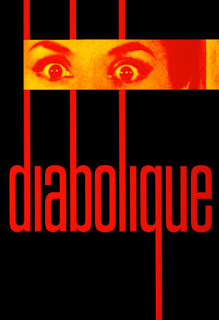 critically acclaimed as influential cinema.
critically acclaimed as influential cinema.
The film takes place at a boarding school, centered around the headmaster's wife and his mistress, who together plot to murder the brutal, demoralizing headmaster. Their plan is well thought out, right down to the plastic tablecloth made ready at the scene. Killing him one place and leaving him to be found in another was another stroke of genius. Except, well....
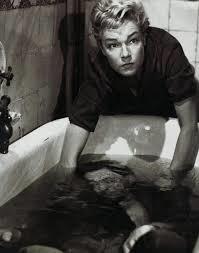 There were many interesting plot points that weaved the story in different directions, letting you know there was more to what you were seeing, but the film was always one step ahead of you. It's not often I'm kept guessing for a long time, and I certainly enjoyed that. The narrative was filmed in a fairly straightforward way, which kept possibilities open as you try to uncover just where this plan went off course. Is it the wife, whose Catholic guilt and weak heart can't handle what she's done? Or is it the level-headed mistress, who's so practical as to leave her accomplice in the lurch? The women play brilliantly off one another, and kept the tension going long after the headmaster is murdered, which was a given in the plot from the very first.
There were many interesting plot points that weaved the story in different directions, letting you know there was more to what you were seeing, but the film was always one step ahead of you. It's not often I'm kept guessing for a long time, and I certainly enjoyed that. The narrative was filmed in a fairly straightforward way, which kept possibilities open as you try to uncover just where this plan went off course. Is it the wife, whose Catholic guilt and weak heart can't handle what she's done? Or is it the level-headed mistress, who's so practical as to leave her accomplice in the lurch? The women play brilliantly off one another, and kept the tension going long after the headmaster is murdered, which was a given in the plot from the very first.
The visual effects on the headmaster's corpse were lovely (by lovely, I mean gruesome), and the scene depicting the act of murder was, like the entire film, straightforward and lacking in frills, which made the ultimate crime resonate all the more strongly for its natural realism.
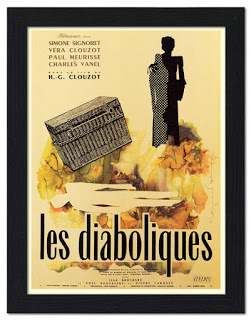 What a nice pictureIn some instances, that realism was taken too far. There were small moments when I noticed interesting camera angles-two or three uses of mirror shots come quickly to mind, but there are not nearly enough of those. The biggest thing missing from this film was a musical score of any kind. If Alfred Hitchcock had gotten his way and bought the rights to this novel adaptation first, there would have been (reek reek reeks!) for sure. Nothing of the sort here. The most remarkable sound was the constant clacking of the women's shoes on the floor. Such an austere aural choice is deliberate, and does lend itself to that naturalist effect, but I can't say for sure that it heightened the tension. If anything, at times the dialogue or tension fell flat without those additional cues. Highs and lows were harder to recognize, and as a result the pacing suffered.
What a nice pictureIn some instances, that realism was taken too far. There were small moments when I noticed interesting camera angles-two or three uses of mirror shots come quickly to mind, but there are not nearly enough of those. The biggest thing missing from this film was a musical score of any kind. If Alfred Hitchcock had gotten his way and bought the rights to this novel adaptation first, there would have been (reek reek reeks!) for sure. Nothing of the sort here. The most remarkable sound was the constant clacking of the women's shoes on the floor. Such an austere aural choice is deliberate, and does lend itself to that naturalist effect, but I can't say for sure that it heightened the tension. If anything, at times the dialogue or tension fell flat without those additional cues. Highs and lows were harder to recognize, and as a result the pacing suffered.
It picks up towards the end as the film draws to its conclusion, which I figured out just at the last minute. It left me wanting more out of the rest of what I'd already seen, but I'm not quite sure what.
I would absolutely recommend it to lovers of international horror and psychological thrillers. But be warned that you have to commit to watching the slowish setup to earn your reward.
K Rating: 8/10
 critically acclaimed as influential cinema.
critically acclaimed as influential cinema.The film takes place at a boarding school, centered around the headmaster's wife and his mistress, who together plot to murder the brutal, demoralizing headmaster. Their plan is well thought out, right down to the plastic tablecloth made ready at the scene. Killing him one place and leaving him to be found in another was another stroke of genius. Except, well....
 There were many interesting plot points that weaved the story in different directions, letting you know there was more to what you were seeing, but the film was always one step ahead of you. It's not often I'm kept guessing for a long time, and I certainly enjoyed that. The narrative was filmed in a fairly straightforward way, which kept possibilities open as you try to uncover just where this plan went off course. Is it the wife, whose Catholic guilt and weak heart can't handle what she's done? Or is it the level-headed mistress, who's so practical as to leave her accomplice in the lurch? The women play brilliantly off one another, and kept the tension going long after the headmaster is murdered, which was a given in the plot from the very first.
There were many interesting plot points that weaved the story in different directions, letting you know there was more to what you were seeing, but the film was always one step ahead of you. It's not often I'm kept guessing for a long time, and I certainly enjoyed that. The narrative was filmed in a fairly straightforward way, which kept possibilities open as you try to uncover just where this plan went off course. Is it the wife, whose Catholic guilt and weak heart can't handle what she's done? Or is it the level-headed mistress, who's so practical as to leave her accomplice in the lurch? The women play brilliantly off one another, and kept the tension going long after the headmaster is murdered, which was a given in the plot from the very first.The visual effects on the headmaster's corpse were lovely (by lovely, I mean gruesome), and the scene depicting the act of murder was, like the entire film, straightforward and lacking in frills, which made the ultimate crime resonate all the more strongly for its natural realism.
 What a nice pictureIn some instances, that realism was taken too far. There were small moments when I noticed interesting camera angles-two or three uses of mirror shots come quickly to mind, but there are not nearly enough of those. The biggest thing missing from this film was a musical score of any kind. If Alfred Hitchcock had gotten his way and bought the rights to this novel adaptation first, there would have been (reek reek reeks!) for sure. Nothing of the sort here. The most remarkable sound was the constant clacking of the women's shoes on the floor. Such an austere aural choice is deliberate, and does lend itself to that naturalist effect, but I can't say for sure that it heightened the tension. If anything, at times the dialogue or tension fell flat without those additional cues. Highs and lows were harder to recognize, and as a result the pacing suffered.
What a nice pictureIn some instances, that realism was taken too far. There were small moments when I noticed interesting camera angles-two or three uses of mirror shots come quickly to mind, but there are not nearly enough of those. The biggest thing missing from this film was a musical score of any kind. If Alfred Hitchcock had gotten his way and bought the rights to this novel adaptation first, there would have been (reek reek reeks!) for sure. Nothing of the sort here. The most remarkable sound was the constant clacking of the women's shoes on the floor. Such an austere aural choice is deliberate, and does lend itself to that naturalist effect, but I can't say for sure that it heightened the tension. If anything, at times the dialogue or tension fell flat without those additional cues. Highs and lows were harder to recognize, and as a result the pacing suffered.It picks up towards the end as the film draws to its conclusion, which I figured out just at the last minute. It left me wanting more out of the rest of what I'd already seen, but I'm not quite sure what.
I would absolutely recommend it to lovers of international horror and psychological thrillers. But be warned that you have to commit to watching the slowish setup to earn your reward.
K Rating: 8/10
Published on March 10, 2017 03:00
March 5, 2017
Yokai Monsters - So Freakin' Creepy
Yokai never cease to interest me. Yokai are local Japanese spirits, that hail from older spiritual traditions. They can be mischievous, vengeful, frightening, and more often than not, physically bizarre. All of these were deliciously true in Yokai Monsters: 100 Monsters (1968).
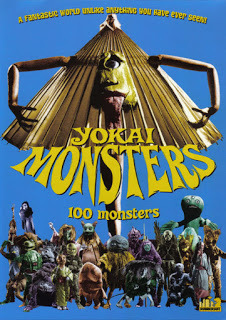 There is something inherent in the film quality of late 1960s horror films that draws me in-the production values are aesthetically pleasing when some care is taken, as it was in this film set in a traditional Japanese village. The costumes were authentic without being bombastic, which I deeply appreciated, and the special effects regarding the yokai are well-crafted and mostly practical, which makes them perfectly uncanny and disturbing. The few monsters that you do see are the stars of this film. The plot of the film is generic, true, but still well-written, and allows the spirits to take center stage as they exact retribution on greedy land developers who seek to destroy an older shrine, committing dozens of other heinous acts for that purpose.
There is something inherent in the film quality of late 1960s horror films that draws me in-the production values are aesthetically pleasing when some care is taken, as it was in this film set in a traditional Japanese village. The costumes were authentic without being bombastic, which I deeply appreciated, and the special effects regarding the yokai are well-crafted and mostly practical, which makes them perfectly uncanny and disturbing. The few monsters that you do see are the stars of this film. The plot of the film is generic, true, but still well-written, and allows the spirits to take center stage as they exact retribution on greedy land developers who seek to destroy an older shrine, committing dozens of other heinous acts for that purpose.
Most interesting was the exposition within the film about rituals regarding the yokai. Set at a party in the villain's home, catering to other Japanese elites, he brings traditional storyteller priests in as entertainment-they tell stories of the ghosts in candlelight, but are not permitted to complete their ritual. When the idiot son encounters a yokai, hilarity ensues. His performance was perhaps the best, the umbrella monster with an extended tongue that fondles him my favorite. That, and the river that speaks. Simplest thing in the world to execute on screen, and yet managed with haunting effect.
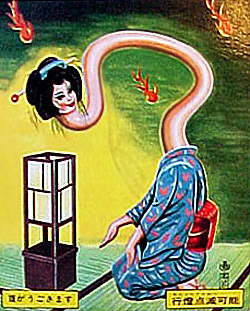 Female with extended neck: another Japanese
Female with extended neck: another Japanese
horror trope done disturbingly well hereI was at turns tickled and creeped out by what I saw, an overall spectacular experience, and I'm glad to say this film turned into a franchise, which I will consume in short order.
K Rating: 9/10
 There is something inherent in the film quality of late 1960s horror films that draws me in-the production values are aesthetically pleasing when some care is taken, as it was in this film set in a traditional Japanese village. The costumes were authentic without being bombastic, which I deeply appreciated, and the special effects regarding the yokai are well-crafted and mostly practical, which makes them perfectly uncanny and disturbing. The few monsters that you do see are the stars of this film. The plot of the film is generic, true, but still well-written, and allows the spirits to take center stage as they exact retribution on greedy land developers who seek to destroy an older shrine, committing dozens of other heinous acts for that purpose.
There is something inherent in the film quality of late 1960s horror films that draws me in-the production values are aesthetically pleasing when some care is taken, as it was in this film set in a traditional Japanese village. The costumes were authentic without being bombastic, which I deeply appreciated, and the special effects regarding the yokai are well-crafted and mostly practical, which makes them perfectly uncanny and disturbing. The few monsters that you do see are the stars of this film. The plot of the film is generic, true, but still well-written, and allows the spirits to take center stage as they exact retribution on greedy land developers who seek to destroy an older shrine, committing dozens of other heinous acts for that purpose.Most interesting was the exposition within the film about rituals regarding the yokai. Set at a party in the villain's home, catering to other Japanese elites, he brings traditional storyteller priests in as entertainment-they tell stories of the ghosts in candlelight, but are not permitted to complete their ritual. When the idiot son encounters a yokai, hilarity ensues. His performance was perhaps the best, the umbrella monster with an extended tongue that fondles him my favorite. That, and the river that speaks. Simplest thing in the world to execute on screen, and yet managed with haunting effect.
 Female with extended neck: another Japanese
Female with extended neck: another Japanesehorror trope done disturbingly well hereI was at turns tickled and creeped out by what I saw, an overall spectacular experience, and I'm glad to say this film turned into a franchise, which I will consume in short order.
K Rating: 9/10
Published on March 05, 2017 17:14
March 2, 2017
Dragon's Dogma - Where's the Story???
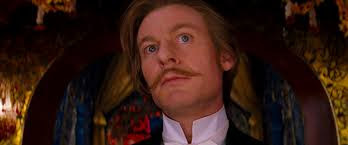 "If I'm to invest, I need to know the story..."
"If I'm to invest, I need to know the story..."-The Duke, Moulin Rouge!
I've been trying to open myself to more RPG style games, after enjoying Ni No Kuni: Wrath of the White Witch immensely. It was an approachable gaming system for someone like me, who's more adept at games like Castlevania and The Legend of Zelda. But the greatest thing about the game was its complex storytelling. I was hoping for something along those lines, but unfortunately Dragon's Dogma missed the mark.
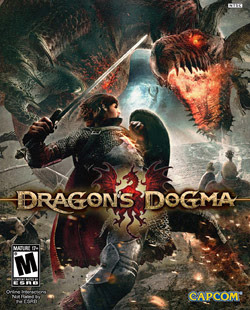 It has lots of things going for it. More than decent design in environments and enemies, even the choices of the player's skillset and equipment. However, there was a big thing missing. I can't even call it a plot hole, because that would imply there was a plot. I suppose there was-an enormous dragon comes around every so often, steals someone's heart, and that person is fated to defeat it. The chosen one is called the Arisen.
It has lots of things going for it. More than decent design in environments and enemies, even the choices of the player's skillset and equipment. However, there was a big thing missing. I can't even call it a plot hole, because that would imply there was a plot. I suppose there was-an enormous dragon comes around every so often, steals someone's heart, and that person is fated to defeat it. The chosen one is called the Arisen.Fine. Generic, but fine. Simple enough. But that's literally it. The entirety of the game is a series of quests, and none of them so central as to forward the imaginary plot. Every task felt like the side-quest action that I'm only sometimes interested in, and when you're waiting for something significant to happen, waiting to be told the steps you need to take to be ready to face the dragon, you end up being employed as the ruler's lackey. There are so many quests, and many of them redundant or repetitive in nature, that although there were many hours of game play, I checked out for a good portion of it (something I can do when my husband's the controller).
By the time we reached the end of the game, we were convinced that we were about to be snookered, about to have everything we knew about the game ripped right out from underneath us, because that couldn't possibly be all there is to the game. Just a setup cut scene in the beginning, lots of quests, and the final boss? No......
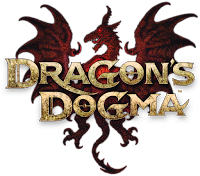 Yes.
Yes.Whether or not you enjoy this title depends entirely on the kind of experience you're looking for. But I'm persnickety about my video games, and expect an immersive, yet still cinematic, experience. So be warned: this isn't that.
K. Rating: 7/10
Published on March 02, 2017 19:20
February 28, 2017
To Cast or Not to Cast - Magical Prompt
Another good blogging email came my way today, this time from Your Next Favorite Author, which provides book and author spotlights along with regular writing prompts.
Selfishly, I'm usually too busy with ongoing projects to stop and do individual prompts, but they are excellent practice, and I keep an eye on the interesting ones nonetheless. Today's was about magic and spell-casting. For a fantasy writer like myself, magic is a driving force. Yet that is the case for most fantasy writers, and it can be hard to stand out. Building fantasy systems has become a complex and competitive game, where sometimes all you want is something different, and other times all you want is something familiar.

I employ a little bit of both in A Vision in Crimson , the fantasy series I'm gearing up to launch in the coming months, and over the course of the series more and more kinds of magic and magical practitioners crop up. Some of it is the kind of Deep Magic you hear about in The Lion, the Witch, and the Wardrobe, that you see in action but never fully understand. Often I thought about the practical rituals of sympathy, conjuring, herbalism, and rootwork, rare natural abilities (that I won't spoil), and cosmic rules and consequences of a complex gaming system like that for Fantasy Flight's Arkham Horror . For those who look closely, there are lots of Lovecraftian threads in my writing, even if there are no Cthulhus. In this series, something important for me was distinguishing between cost and effect, what sacrifices magic requires whether the spells are successful or otherwise, and whether they are worth the sacrifice. In Arkham Horror, spells come with weighty costs, almost as a deterrent to using them in the first place. That concept of danger and risk is featured heavily in the Frostbite series. I'd be pleased to see people's attempts at this prompt here in the comments, or over at Your Next Favorite Author. There will never be too much magic in the world, in my book.
For this prompt, I cheated a little bit, and posted a small scene from A Vision in Crimson , of the first spell that is cast when it's dark, people are tired, and they've got nowhere to sleep. I thought I'd share that with you here, too.
From A Vision in Crimson : Frostbite Book One by Kathryn Troy
Kate returned. She walked right past Luca without even looking at him, and headed towards the fire. She said nothing. She knelt by the fire, grabbing a long, thin branch that was poking out of the center. The end was still lit. Without lifting it off the ground, Kate dragged the smoldering end in the dirt, creating a large spiral that bordered the entire clearing. The incoherent chatter of the camp began to quiet down, and Luca noticed that those too far to the edge of the clearing were deliberately stepping closer, standing inside the inner curve of the spiral. When the outer edges of the spiral met in a closed circle, Kate left the burning stick upright in the ground. She returned to the fire, walking back the way she had come, rather than crossing the lines and going straight for the center. Luca observed Kate closely. He could hear her whispering something, but couldn’t understand her words. When she arrived at the center, she knelt again by the fire. He saw that her soft lips were still moving. From the pouch at her waist, she pulled out a small blue orb, and held it in the palm of her left hand in front of her face. Her eyes were closed. Her right hand drew the dagger from her boot. Her fingers rotated the orb, placing the blade in her left palm between the orb and her hand. She continued to speak, and the fire began to glow stronger and brighter. Luca heard Kate take in a sharp breath, and in the next moment she quickly ran the dagger across her left palm, drawing blood. She squeezed the orb. Hard. When her blood dripped into the fire, it reacted like gasoline. The blaze traveled the path of the spiral Kate had drawn. In the haze created by the flames, a caravan began to take shape. A series of red and gold tents slowly materialized along the outline of the spiral. Their doors flapped open in the breeze to reveal the rich décor inside. The tents were populated by lush pillows and fabrics, cups and bowls made of silver, and incredibly soft-looking beds. In the center, Kate’s blade was still biting into her hand, which had begun to quiver. In a few more minutes, the tents took on a physical form, and Kate let her hands fall limply to her side. Her hand was bleeding profusely. She threw her dagger into the dirt and pulled the plaid scarf out from around her neck, wrapping it tightly around her wound. She picked up her dagger, wiped the blade on her lap, and returned it to its place alongside her leg.
 It doesn't work without the hat...
It doesn't work without the hat...
Selfishly, I'm usually too busy with ongoing projects to stop and do individual prompts, but they are excellent practice, and I keep an eye on the interesting ones nonetheless. Today's was about magic and spell-casting. For a fantasy writer like myself, magic is a driving force. Yet that is the case for most fantasy writers, and it can be hard to stand out. Building fantasy systems has become a complex and competitive game, where sometimes all you want is something different, and other times all you want is something familiar.

I employ a little bit of both in A Vision in Crimson , the fantasy series I'm gearing up to launch in the coming months, and over the course of the series more and more kinds of magic and magical practitioners crop up. Some of it is the kind of Deep Magic you hear about in The Lion, the Witch, and the Wardrobe, that you see in action but never fully understand. Often I thought about the practical rituals of sympathy, conjuring, herbalism, and rootwork, rare natural abilities (that I won't spoil), and cosmic rules and consequences of a complex gaming system like that for Fantasy Flight's Arkham Horror . For those who look closely, there are lots of Lovecraftian threads in my writing, even if there are no Cthulhus. In this series, something important for me was distinguishing between cost and effect, what sacrifices magic requires whether the spells are successful or otherwise, and whether they are worth the sacrifice. In Arkham Horror, spells come with weighty costs, almost as a deterrent to using them in the first place. That concept of danger and risk is featured heavily in the Frostbite series. I'd be pleased to see people's attempts at this prompt here in the comments, or over at Your Next Favorite Author. There will never be too much magic in the world, in my book.
For this prompt, I cheated a little bit, and posted a small scene from A Vision in Crimson , of the first spell that is cast when it's dark, people are tired, and they've got nowhere to sleep. I thought I'd share that with you here, too.
From A Vision in Crimson : Frostbite Book One by Kathryn Troy
Kate returned. She walked right past Luca without even looking at him, and headed towards the fire. She said nothing. She knelt by the fire, grabbing a long, thin branch that was poking out of the center. The end was still lit. Without lifting it off the ground, Kate dragged the smoldering end in the dirt, creating a large spiral that bordered the entire clearing. The incoherent chatter of the camp began to quiet down, and Luca noticed that those too far to the edge of the clearing were deliberately stepping closer, standing inside the inner curve of the spiral. When the outer edges of the spiral met in a closed circle, Kate left the burning stick upright in the ground. She returned to the fire, walking back the way she had come, rather than crossing the lines and going straight for the center. Luca observed Kate closely. He could hear her whispering something, but couldn’t understand her words. When she arrived at the center, she knelt again by the fire. He saw that her soft lips were still moving. From the pouch at her waist, she pulled out a small blue orb, and held it in the palm of her left hand in front of her face. Her eyes were closed. Her right hand drew the dagger from her boot. Her fingers rotated the orb, placing the blade in her left palm between the orb and her hand. She continued to speak, and the fire began to glow stronger and brighter. Luca heard Kate take in a sharp breath, and in the next moment she quickly ran the dagger across her left palm, drawing blood. She squeezed the orb. Hard. When her blood dripped into the fire, it reacted like gasoline. The blaze traveled the path of the spiral Kate had drawn. In the haze created by the flames, a caravan began to take shape. A series of red and gold tents slowly materialized along the outline of the spiral. Their doors flapped open in the breeze to reveal the rich décor inside. The tents were populated by lush pillows and fabrics, cups and bowls made of silver, and incredibly soft-looking beds. In the center, Kate’s blade was still biting into her hand, which had begun to quiver. In a few more minutes, the tents took on a physical form, and Kate let her hands fall limply to her side. Her hand was bleeding profusely. She threw her dagger into the dirt and pulled the plaid scarf out from around her neck, wrapping it tightly around her wound. She picked up her dagger, wiped the blade on her lap, and returned it to its place alongside her leg.
 It doesn't work without the hat...
It doesn't work without the hat...
Published on February 28, 2017 18:42
February 27, 2017
The Art of Dying - Blog Share
I always find something interesting at The Gothic Library. The latest installment is no exception, talking about the peculiar ways and meanings behind death in Gothic literature, when the deaths of characters abound in our everyday media-The Walking Dead, Game of Thrones, etc. etc.
I agree it is essential to remember that, as much as we might miss Glenn Rhee, or, you know, anyone in Westeros, that without the framing of a death in Gothic tropes, the tendency is to minimize that loss. But when a character dies in a Gothic tale, you never let it go. It's the central driving force of the tale: who and how someone died, by whose hands, for what reason...is that person truly dead? Is their soul at rest? If not, how can that be effected? These are the ways of storytelling that make the gothic so wonderful and broad, a genre that won't ever become stale as long as people continue to pour their souls into it.

I'll add to Julia's list of memorable deaths with one that will never leave me: Lady Madeline in "The Fall of the House of Usher," by Edgar A. Poe. Madeline's death is told to the narrator, observing Roderick Usher mental breakdown, accompanied by the literal fall of his house. The haunting mood that Poe describes as Usher's state of mind- telling of Madeline's death, followed by questioning, doubting, denying, and fearing the lack of death and what it hath wrought-it haunts me still.
If you've enjoyed the content on my page and have any affection for Gothic fiction, I heartily recommend The Gothic Library. If Poe is what you're after, read "The Fall of the House of Usher" here.
I agree it is essential to remember that, as much as we might miss Glenn Rhee, or, you know, anyone in Westeros, that without the framing of a death in Gothic tropes, the tendency is to minimize that loss. But when a character dies in a Gothic tale, you never let it go. It's the central driving force of the tale: who and how someone died, by whose hands, for what reason...is that person truly dead? Is their soul at rest? If not, how can that be effected? These are the ways of storytelling that make the gothic so wonderful and broad, a genre that won't ever become stale as long as people continue to pour their souls into it.

I'll add to Julia's list of memorable deaths with one that will never leave me: Lady Madeline in "The Fall of the House of Usher," by Edgar A. Poe. Madeline's death is told to the narrator, observing Roderick Usher mental breakdown, accompanied by the literal fall of his house. The haunting mood that Poe describes as Usher's state of mind- telling of Madeline's death, followed by questioning, doubting, denying, and fearing the lack of death and what it hath wrought-it haunts me still.
If you've enjoyed the content on my page and have any affection for Gothic fiction, I heartily recommend The Gothic Library. If Poe is what you're after, read "The Fall of the House of Usher" here.
Published on February 27, 2017 12:34
February 26, 2017
American Giallo: Body Double
 My interest in Body Double (1984) derived from the role it played in one of my perennial favorites, American Psycho (2000), as one of the films Patrick Bateman constantly watches in the background. I had no idea it was a modern re-envisioning of Alfred Hitchock's Rear Window (1954), nor did I know how much it would bolster my theories about the blurring of national lines when it comes to post-war cinema focused on stylized violence. At present, film scholars tend to think of German krimis, Italian gialli, and American slashers as being somewhat related to each other as artistic efforts in violence, but still bound by certain generic definitions that confine themselves to national borders. I have argued, (and will continue to argue if I ever get around to writing that book), that those genre borders should be re-examined, especially in regard to nationality.
My interest in Body Double (1984) derived from the role it played in one of my perennial favorites, American Psycho (2000), as one of the films Patrick Bateman constantly watches in the background. I had no idea it was a modern re-envisioning of Alfred Hitchock's Rear Window (1954), nor did I know how much it would bolster my theories about the blurring of national lines when it comes to post-war cinema focused on stylized violence. At present, film scholars tend to think of German krimis, Italian gialli, and American slashers as being somewhat related to each other as artistic efforts in violence, but still bound by certain generic definitions that confine themselves to national borders. I have argued, (and will continue to argue if I ever get around to writing that book), that those genre borders should be re-examined, especially in regard to nationality. Being a Peeping Tom can cause all
Being a Peeping Tom can cause allsorts of problems-especially when you witness a murderBody Double is the perfect example of an out-and-out giallo that is NOT Italian. What makes it so? A few things:
*experimental camera angles and framing
*nonlinear storytelling
*stylized violence, usually witnessed
*an amateur investigator as a protagonist
*exploration of memory, selfhood, identity, and voyeurism
*set in an artistic community (actors)
Body Double excelled at all these. Added to this was an intriguing layer of petrifying claustrophobia, which was played brilliantly. Of course, as a Dario Argento fan, the leading director of gialli, I thought this film could have taken some of its scenes even further, but, this is an extraordinary work, and should be witnessed by all serious fans of horror.
K Rating: 10/10
Published on February 26, 2017 13:52
February 16, 2017
Angel of Storms- Too Good to Put Down
After reading something atrocious, (The Nosferatu Scroll, review below) I decided to take a short break from working on my new author goal, and went with a tried and true.
Angel of Storms
, the second volume of Trudi Canavan's new trilogy Millenium's Rule, could wait no longer.
 I barely put the book down in the two and a half days it took me to read it. Canavan is at the top of her game. She is a thoughtful, compelling world builder, able to craft believable, relateable characters who are put through the ringer, and you right along with them. The cosmically epic story of a universe on the cusp of great change is continued through the experiences of two powerful sorcerers, Tyen and Rielle. Rielle's story is a beautiful one, showing how she picked up the pieces of her life after heartbreak, ridicule, and expulsion from her world for accidentally using magic, which is considered stealing from angels. Thing is, the angel that has forgiven her and offered her a new life is no angel-he's the Raen, the most powerful sorcerer in the universe and ruler of all the worlds.
I barely put the book down in the two and a half days it took me to read it. Canavan is at the top of her game. She is a thoughtful, compelling world builder, able to craft believable, relateable characters who are put through the ringer, and you right along with them. The cosmically epic story of a universe on the cusp of great change is continued through the experiences of two powerful sorcerers, Tyen and Rielle. Rielle's story is a beautiful one, showing how she picked up the pieces of her life after heartbreak, ridicule, and expulsion from her world for accidentally using magic, which is considered stealing from angels. Thing is, the angel that has forgiven her and offered her a new life is no angel-he's the Raen, the most powerful sorcerer in the universe and ruler of all the worlds.
The Raen is the most interesting addition to Millenium's Rule. He's super powerful, and the only person whose mind you don't get any insight to. I might have been disappointed by that, if it wasn't so compelling. Like all great and terrible rulers, he makes hard decisions, some with unforseeable consequences. So Canavan has added more universally compelling layers-questions of ethical governance, selfishness/selflessness in the face of great power, and how different perspectives frame "historical truth." He interacts in equal turns with Tyen and Rielle, pulling their lives closer together towards the end, even though their narratives are not truly unified. But as the book comes to a close, you have impressions about where the third is going, and I can't wait.
It's not a perfect book, however. Though what Tyen is doing is more interesting than his flight from his magic-poor home world in Thief's Magic , on the whole he doesn't really experience a whole lot of growth, and his number one motivator, to release Vela from her page-bound prison, hasn't appreciably moved forward. Rielle, however, has progressed in leaps and bounds, and I found myself disappointed whenever her passages were interspliced with Tyen's. The difference between my level of interest in the two mains only grew further in this work.
And:I know Canavan doesn't care about happy endings of a romantic nature, and I absolutely commend her for that. But it's killing me. Really. I feel every heartache like it's my own,which makes her a wonderful writer. Hopefully there will be no more loose ends and happiness enough to go around in the third installment, set to be released on my birthday.
K Rating: 9/10
 I barely put the book down in the two and a half days it took me to read it. Canavan is at the top of her game. She is a thoughtful, compelling world builder, able to craft believable, relateable characters who are put through the ringer, and you right along with them. The cosmically epic story of a universe on the cusp of great change is continued through the experiences of two powerful sorcerers, Tyen and Rielle. Rielle's story is a beautiful one, showing how she picked up the pieces of her life after heartbreak, ridicule, and expulsion from her world for accidentally using magic, which is considered stealing from angels. Thing is, the angel that has forgiven her and offered her a new life is no angel-he's the Raen, the most powerful sorcerer in the universe and ruler of all the worlds.
I barely put the book down in the two and a half days it took me to read it. Canavan is at the top of her game. She is a thoughtful, compelling world builder, able to craft believable, relateable characters who are put through the ringer, and you right along with them. The cosmically epic story of a universe on the cusp of great change is continued through the experiences of two powerful sorcerers, Tyen and Rielle. Rielle's story is a beautiful one, showing how she picked up the pieces of her life after heartbreak, ridicule, and expulsion from her world for accidentally using magic, which is considered stealing from angels. Thing is, the angel that has forgiven her and offered her a new life is no angel-he's the Raen, the most powerful sorcerer in the universe and ruler of all the worlds.The Raen is the most interesting addition to Millenium's Rule. He's super powerful, and the only person whose mind you don't get any insight to. I might have been disappointed by that, if it wasn't so compelling. Like all great and terrible rulers, he makes hard decisions, some with unforseeable consequences. So Canavan has added more universally compelling layers-questions of ethical governance, selfishness/selflessness in the face of great power, and how different perspectives frame "historical truth." He interacts in equal turns with Tyen and Rielle, pulling their lives closer together towards the end, even though their narratives are not truly unified. But as the book comes to a close, you have impressions about where the third is going, and I can't wait.
It's not a perfect book, however. Though what Tyen is doing is more interesting than his flight from his magic-poor home world in Thief's Magic , on the whole he doesn't really experience a whole lot of growth, and his number one motivator, to release Vela from her page-bound prison, hasn't appreciably moved forward. Rielle, however, has progressed in leaps and bounds, and I found myself disappointed whenever her passages were interspliced with Tyen's. The difference between my level of interest in the two mains only grew further in this work.
And:I know Canavan doesn't care about happy endings of a romantic nature, and I absolutely commend her for that. But it's killing me. Really. I feel every heartache like it's my own,which makes her a wonderful writer. Hopefully there will be no more loose ends and happiness enough to go around in the third installment, set to be released on my birthday.
K Rating: 9/10
Published on February 16, 2017 19:32
February 12, 2017
Blair Witch - A Worthy Successor
In some ways Blair Witch was better than the original
The Blair Witch Project
, but the ways in which it succeeds only work because of the original. I appreciated that the storyline kept tightly to the feel of the first, and they benefited from having a strong foundation that they could build on.
[image error] The main character James is looking for his sister Heather, who disappeared in the first film. He brings along a bunch of friends and a bundle of new technology. The droid was a favorite of mine, because it provided lots some very interesting shots, and revealed an important component of the Maryland forest that they get lost in, and adds another layer to the story of Heather and her two buddies getting lost in the same forest, in much the same fashion.
The introduction of two additional characters who claimed to find Heather's footage was very smart too. Because it begs the question: how likely is it that this guy just happens to own a camera that can play Heather's tape? If you remember back, she had hand-selected those cameras for special functions. It's fairly obvious that he not only found her tape, but her camera. A really nice tie-in, and it adds tension to the current story, because you know these two newcomers are not telling everything they know.
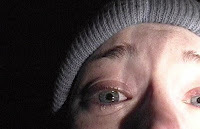 Lighting and sound editing are phenomenal throughout. That becomes even more apparent in the last act, spent inside the house. It was terrifying enough to come across this dilapidated structure literally out of nowhere in the first film. Here, it's a bit clearer that the house doesn't truly exist: not according to their technology at least-it's not a permanent structure in the real world, but the characters can enter it. Whether or not they can exit is still a question. There's a strong play with a traditional haunting mechanism here: the breakdown of linear time exhibited through sound. It's executed with terrifyingly brilliant effect here, and as your eyes are peeled to what you're watching, your mind is racing to connect it to what you've already seen. It makes The Blair Witch Project present and urgent, doubling down on the scare factor of these crucial moments.
Lighting and sound editing are phenomenal throughout. That becomes even more apparent in the last act, spent inside the house. It was terrifying enough to come across this dilapidated structure literally out of nowhere in the first film. Here, it's a bit clearer that the house doesn't truly exist: not according to their technology at least-it's not a permanent structure in the real world, but the characters can enter it. Whether or not they can exit is still a question. There's a strong play with a traditional haunting mechanism here: the breakdown of linear time exhibited through sound. It's executed with terrifyingly brilliant effect here, and as your eyes are peeled to what you're watching, your mind is racing to connect it to what you've already seen. It makes The Blair Witch Project present and urgent, doubling down on the scare factor of these crucial moments.
 The tightness of the house set, how they move through it and suggest the ambiguity of cellar vs. attic as the focus of the haunting, and the witch herself: all of these are utter perfection. Highest marks to this one, and hope that other filmmakers will look to all this movie got right to bring us more bone-chilling cinema in 2017.
The tightness of the house set, how they move through it and suggest the ambiguity of cellar vs. attic as the focus of the haunting, and the witch herself: all of these are utter perfection. Highest marks to this one, and hope that other filmmakers will look to all this movie got right to bring us more bone-chilling cinema in 2017.
K Rating: 10/10
[image error] The main character James is looking for his sister Heather, who disappeared in the first film. He brings along a bunch of friends and a bundle of new technology. The droid was a favorite of mine, because it provided lots some very interesting shots, and revealed an important component of the Maryland forest that they get lost in, and adds another layer to the story of Heather and her two buddies getting lost in the same forest, in much the same fashion.
The introduction of two additional characters who claimed to find Heather's footage was very smart too. Because it begs the question: how likely is it that this guy just happens to own a camera that can play Heather's tape? If you remember back, she had hand-selected those cameras for special functions. It's fairly obvious that he not only found her tape, but her camera. A really nice tie-in, and it adds tension to the current story, because you know these two newcomers are not telling everything they know.
 Lighting and sound editing are phenomenal throughout. That becomes even more apparent in the last act, spent inside the house. It was terrifying enough to come across this dilapidated structure literally out of nowhere in the first film. Here, it's a bit clearer that the house doesn't truly exist: not according to their technology at least-it's not a permanent structure in the real world, but the characters can enter it. Whether or not they can exit is still a question. There's a strong play with a traditional haunting mechanism here: the breakdown of linear time exhibited through sound. It's executed with terrifyingly brilliant effect here, and as your eyes are peeled to what you're watching, your mind is racing to connect it to what you've already seen. It makes The Blair Witch Project present and urgent, doubling down on the scare factor of these crucial moments.
Lighting and sound editing are phenomenal throughout. That becomes even more apparent in the last act, spent inside the house. It was terrifying enough to come across this dilapidated structure literally out of nowhere in the first film. Here, it's a bit clearer that the house doesn't truly exist: not according to their technology at least-it's not a permanent structure in the real world, but the characters can enter it. Whether or not they can exit is still a question. There's a strong play with a traditional haunting mechanism here: the breakdown of linear time exhibited through sound. It's executed with terrifyingly brilliant effect here, and as your eyes are peeled to what you're watching, your mind is racing to connect it to what you've already seen. It makes The Blair Witch Project present and urgent, doubling down on the scare factor of these crucial moments. The tightness of the house set, how they move through it and suggest the ambiguity of cellar vs. attic as the focus of the haunting, and the witch herself: all of these are utter perfection. Highest marks to this one, and hope that other filmmakers will look to all this movie got right to bring us more bone-chilling cinema in 2017.
The tightness of the house set, how they move through it and suggest the ambiguity of cellar vs. attic as the focus of the haunting, and the witch herself: all of these are utter perfection. Highest marks to this one, and hope that other filmmakers will look to all this movie got right to bring us more bone-chilling cinema in 2017.K Rating: 10/10
Published on February 12, 2017 19:56



